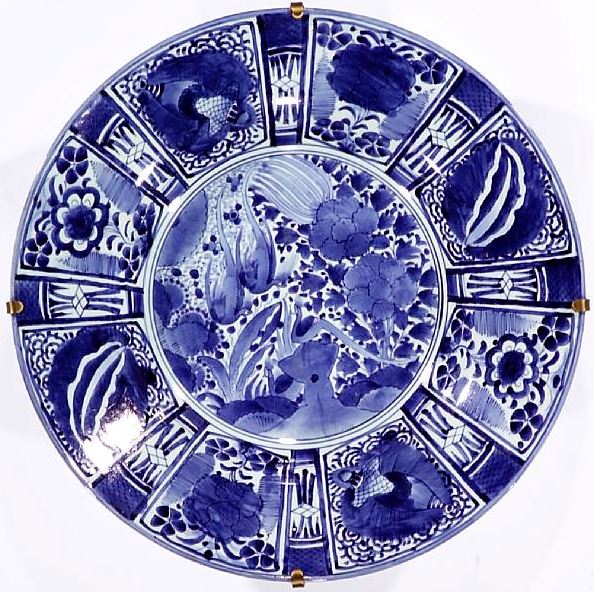Identification and Price guides for Antiques & Collectibles


JAPANESE ARITA PORCELAIN:
How to Research, Identify, and Appraise
Join the most updated and complete collectibles research online - Learn more...
 Arita porcelain, also known as Imari porcelain, is a type of Japanese pottery that has been produced since the 17th century. Arita porcelain is considered to be one of the most collectible types of Japanese porcelain due to its high-quality craftsmanship and unique designs. If you are interested in collecting Arita porcelain, here are some tips on how to research and collect them.
Arita porcelain, also known as Imari porcelain, is a type of Japanese pottery that has been produced since the 17th century. Arita porcelain is considered to be one of the most collectible types of Japanese porcelain due to its high-quality craftsmanship and unique designs. If you are interested in collecting Arita porcelain, here are some tips on how to research and collect them.
What is Arita Porcelain?
Arita porcelain is a type of porcelain that is produced in the town of Arita in the Saga Prefecture of Japan. It is a type of Japanese pottery that has been produced since the 17th century, and it is characterized by its high-quality craftsmanship and unique designs.
The production of Arita porcelain began in 1616 when Korean potters were brought to Japan to teach the Japanese how to produce porcelain. The first Arita porcelain was produced in 1617, and it quickly gained popularity throughout Japan and beyond. Arita porcelain was exported to Europe in the 17th century and became very popular among the wealthy.
How to Identify Arita Porcelain
Arita porcelain can be identified by its unique designs and markings. Arita porcelain is often decorated with blue and white designs, although it can also be decorated with other colors. Arita porcelain is also known for its intricate designs, which often feature birds, flowers, and other natural elements.
One way to identify Arita porcelain is by looking for the “ARITA” mark. This mark is often found on the bottom of Arita porcelain pieces and indicates that the piece was made in Arita. However, not all Arita porcelain pieces are marked, so it is important to look for other identifying characteristics as well.
How to Research Arita Porcelain
If you are interested in collecting Arita porcelain, it is important to do your research. There are many resources available online and in print that can help you learn more about Arita porcelain and its history.
One of the best resources for researching Arita porcelain is the internet. There are many websites and online forums dedicated to Arita porcelain, where you can find information about different types of Arita porcelain, as well as tips on how to collect and care for it.
Another great resource for researching Arita porcelain is books. There are many books available that provide in-depth information about Arita porcelain and its history. Some of the most popular books on Arita porcelain include “The Imari Ware,” by Genichiro Inokuma, and “Arita Porcelain Today,” by Takeshi Nagatake.
If you are interested in learning more about Arita porcelain in person, you may want to consider visiting Arita itself. Arita is home to many museums and galleries that showcase Arita porcelain and its history. By visiting Arita, you can see firsthand the craftsmanship and beauty of Arita porcelain.
How to Collect Arita Porcelain
If you are interested in collecting Arita porcelain, there are several things to keep in mind. First, it is important to only purchase authentic Arita porcelain. There are many imitations and reproductions on the market, so it is important to be knowledgeable about the characteristics of authentic Arita porcelain.
One way to ensure that you are purchasing authentic Arita porcelain is to purchase from a reputable dealer. There are many dealers who specialize in Arita porcelain, and they can provide you with information about the piece you are purchasing, as well as its history and value.
It is also important to care for your Arita porcelain properly. Arita porcelain should be handled carefully and stored in a dry, cool place. If you are displaying your Arita porcelain, it is important to keep it out of direct sunlight, as this can cause the colors to fade over time. You should also avoid placing Arita porcelain near sources of heat or moisture, as this can cause cracking or warping.
When collecting Arita porcelain, it is important to consider the style and design of the piece. Arita porcelain comes in many different styles, from traditional blue and white designs to more modern and abstract styles. Consider the aesthetic of your collection and choose pieces that complement each other and your personal taste.
It is also important to consider the rarity and value of the piece. Some Arita porcelain pieces are more rare and valuable than others, so it is important to do your research and consult with experts if you are unsure about a piece’s value.
Finally, it is important to enjoy your collection of Arita porcelain. Collecting Arita porcelain can be a fun and rewarding hobby, and it is important to take the time to appreciate the beauty and history of each piece in your collection.
Conclusion
Arita porcelain is a unique and beautiful type of Japanese porcelain that has been produced since the 17th century. Collecting Arita porcelain can be a fun and rewarding hobby, but it is important to do your research and purchase authentic pieces from reputable dealers. By following these tips, you can build a collection of Arita porcelain that is both valuable and aesthetically pleasing.
Unlock the true value of your collection with our comprehensive research guides from identifying makers' marks to appraising all kinds of antiques and collectibles, including items featured in this article.
Our up-to-date information will give you an accurate understanding of your items' worth. Don't miss out on this valuable resource - visit our research tools today!
In addition to some examples shown below on this page, you can also search our price guide for your own treasures.
Examples of related items from our Price Guides
-
A LARGE JAPANESE ARITA PORCELAIN BOWL Edo [more like this]
-
THREE JAPANESE ARITA PORCELAIN BOWLS Middle [more like this]
-
JAPANESE PORCELAIN BLUE AND WHITE PLATE, [more like this]
-
JAPANESE ARITA IMARI PORCELAIN CHARGER, 18" [more like this]
-
SET OF THIRTEEN JAPANESE BLUE AND RED ARITA [more like this]
-
JAPANESE ARITA PORCELAIN SAUCER DISHBlue [more like this]
-
JAPANESE AND CHINESE OBJECTS. Includes a [more like this]
-
15 PC. JAPANESE ARITA PORCELAIN TEA SERVICE. [more like this]
-
PR BRONZE MOUNTED JAPANESE PORCELAIN CARP [more like this]
-
JAPANESE EXPORT ARITA PORCELAIN FIGURE OF [more like this]
-
A LARGE 19TH CENTURY JAPANESE SOMETSUKE ARITA [more like this]
-
A Japanese Arita Porcelain Dish, Fuki Chosun [more like this]
There are many more auction results available to our members...
Explore more items from our
Antiques & Collectibles Price Guide
This list is limited to only a few results.
Many more items are available to our members through our
Price Guides!






